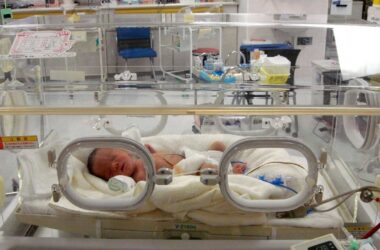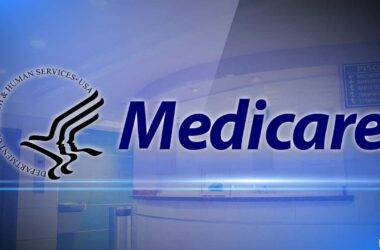Bethesda, Maryland–(ENEWSPF)–January 27, 2011. Cardiac arrests that can be treated by electric stimulation, also known as shockable arrests, were found at a higher frequency in public settings than in the home, according to a National Institutes of Health-funded study appearing in the Jan. 27 issue of the New England Journal of Medicine.
The study compared home and public cardiac arrests under various scenarios. For example, the study considered whether bystanders or emergency medical services (EMS) personnel witnessed the cardiac arrest, and whether the person experiencing the arrest received treatment with an automatic external defibrillator (AED).
In every scenario, a higher percentage of public cardiac arrests were classified as ventricular tachycardia (VT) or ventricular fibrillation (VF), the types of abnormal heart rhythms that can be treated by electric shock.
More than one-third of the people who had a cardiac arrest in public and were treated with an AED survived. This is a significant improvement over the roughly 8 percent national average of cardiac arrest survival. In comparison, the overall survival for home-occurring cardiac arrests treated with an AED was 12 percent.
“To improve the overall disappointing outcome for persons experiencing cardiac arrest, we must know the best immediate treatment,” said Susan Shurin, M.D., acting director of the National Heart, Lung, and Blood Institute (NHLBI), part of the NIH and the major funding agency of this study. “This study provides rich data which indicate the need for further evidence to guide clinical practice and public policy.”
The study is based on data from the world’s largest data registry of pre-hospital cardiac arrest and life-threatening trauma, which is part of the Resuscitation Outcomes Consortium (ROC). The researchers collected cardiac arrest data for over 14,000 people between Dec. 2005 and April 2007. The data spanned over 200 EMS agencies and their receiving hospitals across the United States and Canada.
Among the key findings were that 79 percent of documented cardiac arrests in high-traffic public places where AEDs were available and administered, such as airports or office buildings, were VT or VF. An AED can automatically diagnose an arrhythmia and shock an arrest victim if necessary. In contrast, only 36 percent of home cardiac arrests in which an AED was applied were VT/VF.
Previous studies have found that home-based cardiac arrests have far lower survival rates than arrests that occur in public locations. This study found that only a third of arrests which occurred in homes were witnessed, while over half of those in public locations had witnesses who could immediately call 911 and provide assistance.
The importance of having someone who can provide or call for help does not exclude the possibility that the types of cardiac arrests occurring in home may differ from those occurring in public settings, or that those occurring in public may be more likely to be effectively treated with electrical stimulation.
The study noted that this significant contrast in prevalence could be due to the fact that individuals who spend more time in public places typically are younger, more active, and have fewer chronic diseases, thus predisposing them to a different class of arrest.
However, according to Dr. Shurin, more work is needed to know whether the differences in rates of rhythms and in outcome are due to underlying differences in severity of disease or in how rapidly responders provide effective therapy.
“These survival results affirm the value of putting AEDs in public locales,” said Myron Weisfeldt, M.D., a cardiologist at Johns Hopkins University in Baltimore and lead author of the study. “Even though the overall frequency of VT/VF arrests has declined over the past few decades, they are still a fairly common occurrence in public settings.”
George Sopko, M.D., ROC project officer and program director in the NHLBI’s Heart Failure and Arrhythmias Branch, added that public awareness and education are still important. The best chance of surviving a cardiac arrest, he noted, involves using AEDs in conjunction with cardiopulmonary resuscitation and immediately calling for medical help.
ROC was funded in 2004, with renewed funding in 2010, to conduct clinical research on treatments for life-threatening traumatic injury or cardiac arrest in real-world settings, typically where patients collapse or are critically injured, before they reach the hospital. ROC consists of 10 regional clinical centers in the United States and Canada. In addition to contributing to the ROC database, these sites conduct multiple collaborative trials and studies aimed at optimizing first-line resuscitation management strategies to improve patient outcomes.
The study was supported by the NHLBI in partnership with the National Institute of Neurological Disorders and Stroke, the U.S. Army Medical Research & Materiel Command, the Canadian Institutes of Health Research–Institute of Circulatory and Respiratory Health, Defence Research and Development Canada, the American Heart Association, and the Heart and Stroke Foundation of Canada.
For more information on:
- Resuscitation Outcomes Consortium, visit https://roc.uwctc.org/tiki/tiki-index.php
- Cardiac Arrest, visit http://www.nhlbi.nih.gov/health/dci/Diseases/scda/scda_whatis.html
Part of the National Institutes of Health, the National Heart, Lung, and Blood Institute (NHLBI) plans, conducts, and supports research related to the causes, prevention, diagnosis, and treatment of heart, blood vessel, lung, and blood diseases, and sleep disorders. The Institute also administers national health education campaigns on women and heart disease, healthy weight for children, and other topics. NHLBI press releases, information on NHLBI’s role in the American Recovery and Reinvestment Act, and other materials are available online at www.nhlbi.nih.gov.
Source: nih.gov








